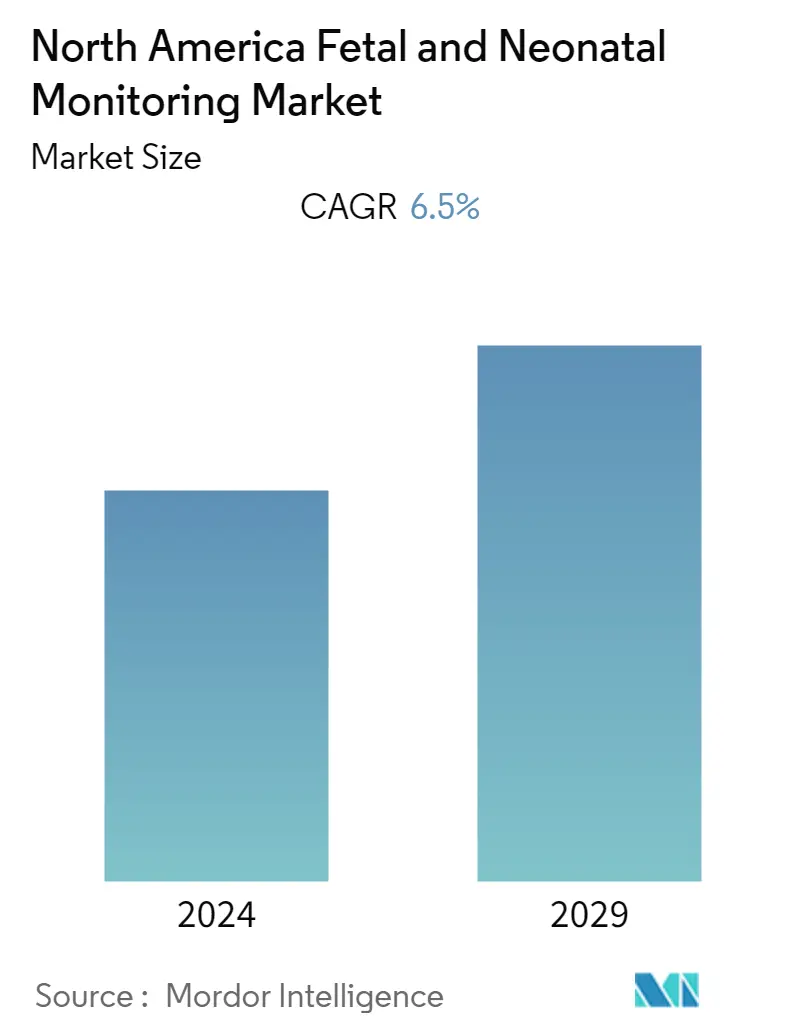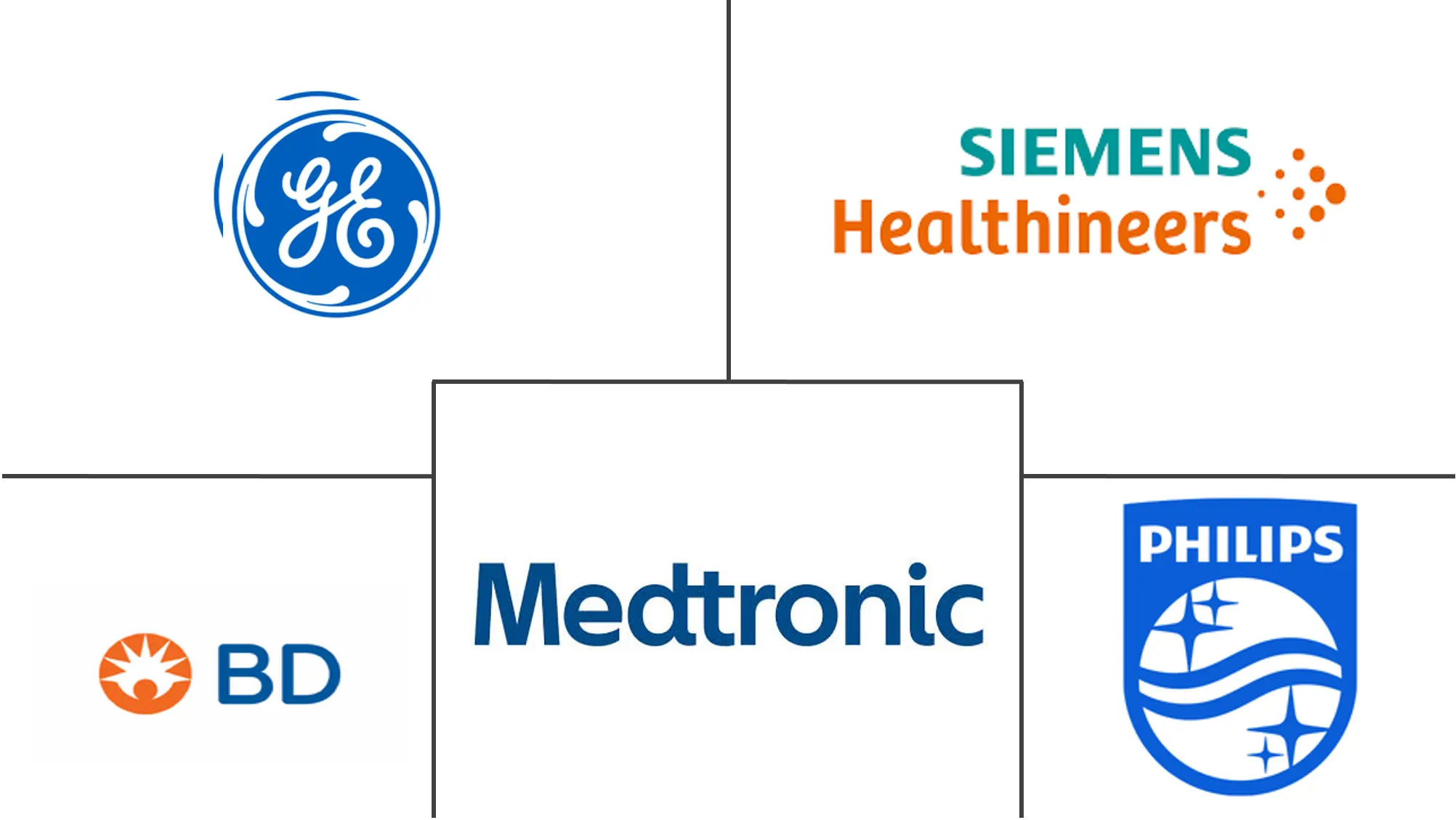Market Size of North America Fetal and Neonatal Monitoring Industry

| Study Period | 2019 - 2029 |
| Base Year For Estimation | 2023 |
| Forecast Data Period | 2024 - 2029 |
| Historical Data Period | 2019 - 2022 |
| CAGR | 6.50 % |
| Market Concentration | Medium |
Major Players
*Disclaimer: Major Players sorted in no particular order |
North America Fetal and Neonatal Monitoring Market Analysis
The North American fetal and neonatal monitoring market is expected to register a CAGR of 6.5% over the forecast period.
The COVID-19 pandemic had a significant impact on the fetal and neonatal monitoring market. According to the research article published in the Journal of Perinatology, 2020, low rates of perinatal transmission of the COVID-19 virus among neonates born to SARS-CoV-2 positive mothers were observed. However, as per the National Registry for Surveillance and Epidemiology of Perinatal COVID-19 Infection (NPC-19), 2020, an incidence of 44 COVID-19 positive cases were observed out of 2287 neonates born to mothers with confirmed SARS-CoV-2 infection. Though newborns are at lower risk of developing the infection, utmost care, and monitoring are required in instances of COVID-19 infection among infants, which majorly involves continuous monitoring of blood oxygen levels and heartbeat. In this context, the studied market is expected to be significantly impacted during the pandemic.
Fetal & neonatal monitoring is important in delivering life-sustaining, non-invasive, and developmentally supportive care to neonates and in providing a quiet and serene environment to protect the development of the fetus. The major share of the region in the market growth can be attributed to the fast-growing birth rate, preterm births, and expanding population.
According to the Centers for Disease Control and Prevention (CDC), in 2020, about 1 in 10 babies was born too early in the United States. This indicates the high number of preterm births in the country, which ultimately increases the demand for incubator devices. With the rise of preterm birth numbers, the demand for the rise in fetal and neonatal care equipment also increases, which is likely to drive the market in the region.
Additionally, increasing product approvals are expected to drive market growth. For instance, In May 2021 Medtronic plc launched the SonarMed airway monitoring system. The Sonarmed airway monitoring system utilizes acoustic technology to check for endotracheal tube obstruction and verify position in real-time giving clinicians vital information required to make more informed, life-saving decisions for Neonates and Infants.
Thus the above-mentioned factors are expected to drive the growth of the market during the forecast period.
North America Fetal and Neonatal Monitoring Industry Segmentation
As per the scope of the report, fetal and neonatal monitoring devices machines used for monitoring and designed to take care of the unique needs of unborn fetal and newborn babies. The North America Fetal and Neonatal Monitoring Market is segmented by Product (Fetal Monitoring Devices and Neonatal Monitoring Devices), End-User (Hospitals, Neonatal Care Centers, and Others End Users) and Geography (United States, Canada and Mexico). The report offers the value (in USD million) for the above segments.
| By Product Type | |||||||
| |||||||
|
| By End User | |
| Hospitals | |
| Neonatal Care Centers | |
| Other End-users |
| Geography | |
| United States | |
| Canada | |
| Mexico |
North America Fetal and Neonatal Monitoring Market Size Summary
The North American fetal and neonatal monitoring market is poised for significant growth, driven by an increasing birth rate, a rise in preterm births, and a growing population. The market's expansion is further supported by the region's robust healthcare infrastructure and high healthcare expenditures, particularly in the United States. The demand for advanced monitoring devices is fueled by the need for continuous and non-invasive care for neonates, especially those born prematurely or with health complications. The COVID-19 pandemic highlighted the importance of these monitoring systems, as they are crucial for managing the health of infants born to infected mothers. The introduction of innovative products, such as Medtronic's SonarMed airway monitoring system, underscores the ongoing advancements in this field, enhancing the ability to provide critical care to vulnerable populations.
The market is characterized by the presence of key players like Medtronic PLC, Becton, Dickinson and Company, Koninklijke Philips NV, GE Company (GE Healthcare), and Siemens Healthineers, who are actively involved in developing and manufacturing cutting-edge monitoring equipment. The United States, in particular, is a focal point for research and development in fetal and neonatal medical devices, supported by favorable policies and insurance coverage that facilitate access to advanced care. The adoption of new technologies, such as the AI baby monitor by Pxierra and the remote pregnancy monitoring platform by Nuvo Group, reflects the industry's commitment to improving neonatal outcomes. These factors collectively contribute to the anticipated growth of the fetal and neonatal monitoring market in North America over the forecast period.
North America Fetal and Neonatal Monitoring Market Size - Table of Contents
-
1. MARKET DYNAMICS
-
1.1 Market Overview
-
1.2 Market Drivers
-
1.2.1 Increasing Number of Preterm and Low-weight Births
-
1.2.2 Advanced Technology in Fetal and Prenatal Monitoring
-
-
1.3 Market Restraints
-
1.3.1 Stringent Regulatory Procedures
-
-
1.4 Porter's Five Force Analysis
-
1.4.1 Threat of New Entrants
-
1.4.2 Bargaining Power of Buyers/Consumers
-
1.4.3 Bargaining Power of Suppliers
-
1.4.4 Threat of Substitute Products
-
1.4.5 Intensity of Competitive Rivalry
-
-
-
2. MARKET SEGMENTATION (Market Size by Value - USD million)
-
2.1 By Product Type
-
2.1.1 Fetal Monitoring Devices
-
2.1.1.1 Heart Rate Monitors
-
2.1.1.2 Uterine Contraction Monitor
-
2.1.1.3 Pulse Oximeters
-
2.1.1.4 Other Fetal Monitoring Devices
-
-
2.1.2 Neonatal Monitoring Devices
-
2.1.2.1 Cardiac Monitors
-
2.1.2.2 Capnographs
-
2.1.2.3 Blood Pressure Monitors
-
2.1.2.4 Pulse Oximeters
-
2.1.2.5 Other Neonatal Monitoring Devices
-
-
-
2.2 By End User
-
2.2.1 Hospitals
-
2.2.2 Neonatal Care Centers
-
2.2.3 Other End-users
-
-
2.3 Geography
-
2.3.1 United States
-
2.3.2 Canada
-
2.3.3 Mexico
-
-
North America Fetal and Neonatal Monitoring Market Size FAQs
What is the current North America Fetal and Neonatal Monitoring Market size?
The North America Fetal and Neonatal Monitoring Market is projected to register a CAGR of 6.5% during the forecast period (2024-2029)
Who are the key players in North America Fetal and Neonatal Monitoring Market?
Koninklijke Philips NV, Medtronic Plc, GE Healthcare, Becton, Dickinson and Company and Siemens Healthineers are the major companies operating in the North America Fetal and Neonatal Monitoring Market.

